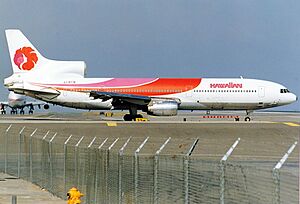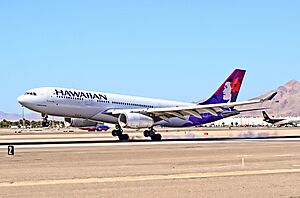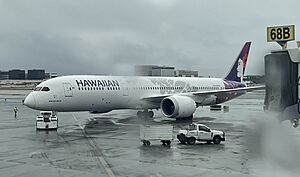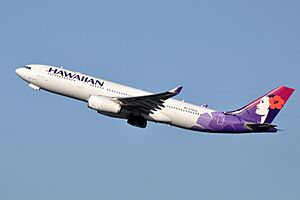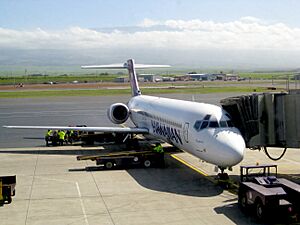Hawaiian Airlines facts for kids
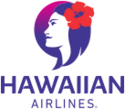
A Hawaiian Airlines Airbus A330
|
|
| Founded | January 30, 1929, as Inter-Island Airways |
|---|---|
| Commenced operations | October 6, 1929 |
| AOC # | HALA005A |
| Hubs |
|
| Frequent-flyer program | HawaiianMiles |
| Fleet size | 75 |
| Destinations | 31 |
| Parent company | Alaska Air Group |
| Headquarters | Honolulu, Hawaii, United States |
| Key people |
|
| Revenue | US$869 million (2024) |
| Net income | US$(58) million (2024) |
| Total assets | US$4.4 billion (2024) |
| Employees | |
Hawaiian Airlines, Inc. (which in Hawaiian is Hui Mokulele o Hawaiʻi) is an airline based in Honolulu, Hawaii. It is part of the Alaska Air Group. Hawaiian Airlines is the biggest airline flying to and from the state of Hawaii. It is also one of the ten largest airlines in the United States based on how many people it flies.
The airline's main base is at Daniel K. Inouye International Airport in Oʻahu. It also has a second base at Kahului Airport in Maui. Hawaiian Airlines offers flights between the Hawaiian islands. It also flies to other Pacific islands like American Samoa and Tahiti. You can also fly with them to Alaska, the U.S. mainland, and other countries like Australia, Canada, Japan, New Zealand, and South Korea.
Hawaiian Airlines is the oldest American airline that has never had a serious accident where people were hurt or a plane was completely destroyed. It is also often ranked as the most on-time airline in the country. The airline is known for having very few flight cancellations, not selling too many tickets for a flight, and handling bags well.
On December 3, 2023, Alaska Air Group announced that it planned to buy Hawaiian Airlines. After getting approval from the government, the purchase was completed on September 18, 2024.
Contents
History of Hawaiian Airlines
Starting Out (1929–1984)
The airline we know today as Hawaiian Airlines started as Inter-Island Airways on January 30, 1929. This company was a part of the Inter-Island Steam Navigation Company. It began flying on October 6, 1929, using a Bellanca CH-300 Pacemaker plane for short sightseeing tours over Oʻahu. Regular flights started a month later, on November 11. They used Sikorsky S-38 planes to fly from Honolulu to Hilo, with stops on Molokaʻi and Maui.
On October 1, 1941, the company changed its name to Hawaiian Airlines. This happened as they stopped using their older Sikorsky S-38 and Sikorsky S-43 flying boats. The first Douglas DC-3 planes joined the fleet in August 1941. Some of these planes were used until November 1968.
In 1952, Hawaiian Airlines started using more modern planes called the Convair 340. More Convair 440s were added between 1959 and 1960. Most of these Convair planes were changed to use turbine propellers from 1965 to 1967. The last ones were sold in 1974.
Hawaiian Airlines began offering jet flights in 1966. They bought Douglas DC-9-10 aircraft, which made travel times much shorter on most of their routes.
From 1973, the airline's logo showed the face of Miss Hawaii 1964, Leina'ala Drummond. She had worked as a flight attendant for the airline.
Growing Beyond Hawaii (1984–1994)
In the 1980s, Hawaiian Airlines started to fly to more places. This was because of strong competition on flights between the islands. In 1985, the airline began offering special charter flights to the South Pacific and other parts of the Pacific using Douglas DC-8 planes. However, they had to stop these flights when the government banned older DC-8 and B707 planes without special noise-reducing equipment from flying in the U.S.
Soon after, in early 1985, the company received its first two leased Lockheed L-1011 TriStar planes. One of these planes was used for Hawaiian's first regular flight outside of Hawaii. This was a daily flight from Honolulu to Los Angeles. This new service meant Hawaiian was now competing directly with bigger U.S. airlines. In 1985 and 1986, Hawaiian Airlines added more L-1011s to its fleet. They used them to start flights to other cities on the West Coast, such as San Francisco, Seattle, Portland, Las Vegas, and Anchorage.
Hawaiian Airlines also started flying to new international places like Australia and New Zealand in 1986. These flights included a stop in Pago Pago International Airport. The airline also grew its international charter business and took on military transport jobs. This helped the company's income grow a lot.
In the 1980s, Hawaiian also helped build Kapalua Airport on the west side of Maui. This airport opened in 1987. It had a short runway, which meant only smaller planes could use it. When the airport first opened, Hawaiian Airlines was the only inter-island airline with planes that could fly there. With its de Havilland Canada DHC-7 Dash 7 planes, Hawaiian had a big advantage in the Maui market.
As the 1990s began, Hawaiian Airlines faced money problems. They had lost millions of dollars in the three years before. Because the airline was losing so much money, it filed for Chapter 11 bankruptcy protection in September 1993. During this time, the company cut many of its costs. It reorganized its debt, got employees to agree to changes, reduced too many flights, and simplified its fleet by selling many planes it had bought just a few years earlier.
As part of its changes, Hawaiian sold Kapalua Airport to the State of Hawaii in 1993. Hawaiian soon stopped flying to that airport as it retired its Dash 7 planes. When the Dash 7 planes were retired in 1994, the airline had an all-jet fleet. Hawaiian Airlines came out of bankruptcy in September 1994.
All Jet Fleet (1994–2003)

To replace its old DC-8s and L-1011s, Hawaiian Airlines leased six DC-10 planes from American Airlines. American Airlines also continued to help maintain these planes. Hawaiian also made a deal with American to use American's SABRE reservation system and join American Airlines' AAdvantage frequent flyer program. The DC-10s were later retired between 2002 and 2003. Hawaiian replaced these leased DC-10s with 14 leased Boeing 767 planes. This was part of a plan to update its fleet, which also replaced its DC-9s with new Boeing 717 aircraft. The Boeing planes featured an updated version of the company's "Pualani" tail art, which had been on its Douglas planes since the 1970s. Pualani means "flower of the sky" and is a key symbol for Hawaiian's brand. On the planes, a silver lei with woven pakalana flowers wraps around the body of the aircraft.
In October 2002, Hawaiian started flying to Phoenix Sky Harbor airport using its Boeing 767–300 planes.
Second Bankruptcy and Reorganization (2003–2005)
In March 2003, Hawaiian Airlines filed for Chapter 11 bankruptcy protection for the second time. The airline continued to operate normally. At that time, it owed $4.5 million in payments to its pilots' retirement plan. It was suggested within the company that this plan should be ended. By May 2005, Hawaiian Airlines had received court approval for its plan to reorganize. The company came out of bankruptcy protection on June 2, 2005. It had lower operating costs because it had new agreements with its employee unions and changed its plane leases. Also, RC Aviation, a part of Ranch Capital, invested in the company.
After Bankruptcy (2005–2012)
On September 28, 2005, Hawaiian Airlines started daily nonstop flights from Honolulu to San Jose, California. This made San Jose the fifth city in California that Hawaiian served. The others were Los Angeles, San Diego, Sacramento, and San Francisco.
On May 4, 2006, Hawaiian Airlines added more flights between the U.S. mainland and Hawaii. This was because they were getting four more Boeing 767–300 planes. They mainly focused on adding nonstop flights to Kahului Airport from San Diego, Seattle, and Portland. More flights were also added between Honolulu and the cities of Sacramento, Seattle, and Los Angeles. In 2006, Hawaiian Airlines was named the best airline serving Hawaii by Travel + Leisure, Zagat, and Condé Nast Traveler.
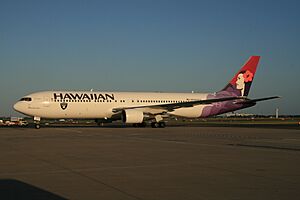
On July 24, 2007, Hawaiian Airlines and Air New Zealand signed a $45 million contract. Air New Zealand would perform major maintenance on Hawaiian's Boeing 767 planes for five years. In August 2007, the Seattle Seahawks became the second sports team to use Hawaiian Airlines for travel to games. The Las Vegas Raiders, another NFL team, had been flying with Hawaiian Airlines since the 1990s. Both teams used to fly on Hawaiian's Boeing 767s, but now they travel on Hawaiian's Airbus A330s. Some of Hawaiian's Boeing 767 and A330 planes have stickers with the Raiders' logos.
In March 2008, the airline started nonstop flights to Manila, the capital of the Philippines. This was the airline's first big international expansion since it came out of bankruptcy in June 2005. Because ATA Airlines and Aloha Airlines closed, Hawaiian began flights to Oakland on May 1, 2008.
On February 16, 2010, Hawaiian Airlines asked the United States Department of Transportation for permission to start nonstop flights from its hub in Honolulu to Tokyo-Haneda in 2010. Hawaiian was one of five U.S. airlines that wanted to fly to Haneda. Approval was given, and the flight started on November 18, 2010. The airline also planned to work with All Nippon Airways.
On January 12, 2011, Hawaiian Airlines began nonstop service to Seoul-Incheon, South Korea. On March 31, 2011, Hawaiian announced that it would be updating the check-in area of the inter-island terminal at Honolulu International Airport. Hawaiian, the only airline using this terminal, removed the old check-in counters. They installed six round check-in islands in the middle of the lobbies. These islands can be used for inter-island, mainland, and international flights. On July 12, 2011, Hawaiian added Osaka, Japan, to its network. On November 17, 2011, Hawaiian ordered five more Airbus A330-200 planes.
On June 4, 2012, Hawaiian expanded to the east coast with daily flights to New York's John F. Kennedy International Airport. On August 30, 2012, Hawaiian asked the U.S. Department of Transportation for a nonstop route between Kona and Tokyo-Haneda. This would fill a gap left by Japan Airlines, which had stopped service to Kona almost two years earlier. However, the U.S. Department of Transportation did not approve the airline's request. On December 3, 2012, the airline announced plans to start flights to Taipei, Taiwan, beginning July 9, 2013, as part of its big expansion plans.
More Growth and New Airline (2013–2023)
On February 11, 2013, the airline announced a new project for inter-island flights using propeller planes, called "’Ohana by Hawaiian”. This service was operated by Empire Airlines using ATR 42–500 turboprop planes. The service began on March 11, 2014, to Molokaʻi and Lānaʻi. The airline added more "ʻOhana by Hawaiian" routes between Kahului, Kailua-Kona, and Hilo in the summer of 2014. On April 10, 2013, the airline announced its first destination in China, with service to Beijing expected to start on April 16, 2014. At the same time, the airline announced it would end service to Manila on July 31, 2013. On July 11, 2013, the airline signed an agreement to share flights with China Airlines.
On March 12, 2014, Hawaiian announced it would start daily service between Kahului and Los Angeles on May 2. They added a second flight from June 30 to September 8 because many passengers wanted it. They also started nonstop summer flights between Los Angeles and both Līhuʻe, Kauaʻi, and Kona, Hawaiʻi. On August 14, 2014, the airline announced direct service between Kahului and San Francisco starting in November.
On January 5, 2015, Hawaiian again asked the U.S. Department of Transportation (DOT) for the Kona-Haneda route. If approved, service would begin in June. On March 31, the DOT again denied the request.
On May 1, 2017, the airline showed off a new logo and design for its planes.
On March 6, 2018, the airline announced it would order 10 Boeing 787–9 Dreamliner planes. They also had options to buy ten more. On January 4, 2023, they announced an order for two more 787-9 planes.
Due to the economic effects of the COVID-19 pandemic, Hawaiian Airlines reported losing over $100 million in the second quarter of 2020. Travel quarantines, which were put back in place for August 2020, also led to Hawaiian Airlines planning to make the company smaller by 15–25% by summer 2021.
On May 27, 2021, Hawaiian announced it would stop the 'Ohana by Hawaiian brand and its cargo and passenger services. This was because the pandemic and quarantines greatly affected travel between the islands. The airline decided the service was no longer possible. The ATR planes used for 'Ohana would be moved to the mainland and prepared for sale.
On April 25, 2022, Hawaiian Airlines announced it would be the first major airline to offer SpaceX Starlink internet service on all flights across the Pacific Ocean. This service would be free for passengers starting in 2023. In September 2024, Hawaiian announced it had installed Starlink on its Airbus planes.
On May 15, 2023, Hawaiian Airlines introduced the new "Leihōkū Suites" on their Boeing 787–9 Dreamliner planes. These suites offer a space with seats that can lie completely flat, an 18-inch entertainment screen, personal outlets, wireless charging, and direct access to the aisle. The design of these suites is inspired by Hawaii's natural world.
Joining Alaska Air Group (2023–2024)
In December 2023, Alaska Airlines announced it would merge with Hawaiian Airlines by buying it for $1.9 billion. This deal also included taking on about $900 million of Hawaiian's debt. Experts in the airline industry had suggested this merger for years. It would create a combined airline focused on the western United States. The merger would give Alaska, which mainly flies within the U.S. with smaller planes, Hawaiian's larger planes, pilots, and international routes.
The merger would keep both Alaska Airlines and Hawaiian Airlines as separate brands. Hawaiian Airlines would also become a member of the Oneworld airline alliance. The two airlines plan to have a combined frequent-flier program. Alaska's Mileage Plan will likely replace HawaiianMiles. Hawaiian Airlines shareholders approved the merger in April 2024.
The U.S. Department of Justice had been trying to prevent more mergers in the airline industry. However, on August 19, 2024, the U.S. Department of Justice finished its review and decided not to try to stop the merger in court. On September 17, 2024, the regulator from the U.S. Department of Transportation approved the merger. This approval came with conditions. These included a one-to-one exchange rate for airline points, keeping many inter-island passenger and cargo flights, continuing service to small Hawaiian communities, allowing children under 13 to sit next to adults they are with, and lower costs for military members and their families.
When the deal was announced, the companies said they only had 12 nonstop routes that overlapped, which they called minimal. Alaska Airlines highlighted its experience flying within Alaska, including to 16 places not reachable by road. They promised to keep a strong schedule of flights between the Hawaiian islands. The Wall Street Journal thought that this merger might lead to higher prices for flights to Hawaii, but the companies disagreed.
When the merger was announced, Governor Josh Green (HI) promised that he and the attorney general Anne Lopez would watch the merger "very closely." He added that both "are very high-quality companies, but ultimately, I will be watching to make sure all of our state's needs are met and all of our workers are cared for." To get local support for the merger, Alaska Airlines made three main promises to Hawaii residents: to keep the Hawaiian Airlines brand, keep all front-line union employees, and protect neighbor island flights. In February 2024, the mayors of Maui County, Honolulu, Kauai County, and Hawaiʻi County wrote an open letter supporting the merger. They said it was "good for Hawaiʻi" and would improve service to the neighbor islands.
Alaska Airlines confirmed that miles in Hawaiian's HawaiianMiles frequent flyer program would be changed to the Alaska Airlines Mileage Plan at a 1:1 ratio.
On September 18, 2024, Alaska Air Group officially completed the purchase of Hawaiian Holdings, Inc.
Company Information
Ownership and Structure
Hawaiian Airlines, Inc. is owned by Alaska Air Group. Hawaiian Holdings, Inc. was the parent company before the purchase. It was listed on NASDAQ from June 2, 2008, to September 18, 2024. Before that, it was listed on the American Stock Exchange. Hawaiian Holdings, Inc. was a company that owned all the shares of Hawaiian Airlines, Inc. On June 30, 2008, the company announced it had been added to the Russell 3000 Index.
Business Trends
Here are some important numbers for Hawaiian Holdings, Inc. (which includes Hawaiian Airlines and the former 'Ohana by Hawaiian) for years ending December 31:
| Year | Revenue (in million US$) |
Net income (in million US$) |
Employees (FTE) |
Passengers (in millions) |
Load factor (%) |
Aircraft | Notes/ references |
|---|---|---|---|---|---|---|---|
| 2014 | 2,315 | 69 | 10.2 | 81.5 | |||
| 2015 | 2,317 | 182 | 10.7 | 81.6 | 54 | ||
| 2016 | 2,432 | 224 | 6,199 | 11.1 | 84.3 | 57 | |
| 2017 | 2,675 | 331 | 6,660 | 11.5 | 85.9 | 60 | |
| 2018 | 2,837 | 233 | 7,244 | 11.8 | 85.3 | 66 | |
| 2019 | 2,832 | 224 | 7,437 | 11.7 | 86.6 | 68 | |
| 2020 | 844 | (511) | 5,278 | 3.4 | 60.6 | 68 | |
| 2021 | 1,596 | (145) | 6,674 | 6.5 | 69.2 | 69 | |
| 2022 | 2,716 | (240) | 7,108 | 10.0 | 80.1 | 64 | |
| 2023 | 2,641 | (261) | 7,362 | 10.9 | 83.5 | 62 |
Where Hawaiian Airlines Flies
Hawaiian Airlines flies to many places in Asia and the Pacific. On January 12, 2011, the airline added its eighth international destination, Incheon International Airport near Seoul, South Korea. It also has daily and weekly direct flights from Honolulu to Tahiti, Australia, South Korea, Japan, and New Zealand.
Airline Partnerships
Hawaiian Airlines works with other airlines through agreements called codeshare agreements. This means they can sell tickets on each other's flights.
- Alaska Airlines
- American Airlines
- JetBlue (ends September 30, 2025)
- Philippine Airlines
- Qantas
- Turkish Airlines
- United Airlines
They also have interline agreements with other airlines. This allows passengers to book flights on different airlines as part of one trip.
- APG Airlines
- Emirates
- Hahn Air
- Japan Transocean Air
- Norse Atlantic Airways
- South African Airways
- Sun Country Airlines
- Virgin Atlantic
Hawaiian Airlines also has a cargo agreement with Southwest Airlines for shipping goods.
Hawaiian Airlines Fleet
As of July 2025, Hawaiian Airlines uses the following planes:
| Aircraft | In service | Orders | Passengers | Refs | Notes | |||
|---|---|---|---|---|---|---|---|---|
| F | Y+ | Y | Total | |||||
| Airbus A321neo | 18 | — | 16 | 44 | 129 | 189 | ||
| Airbus A330-200 | 24 | — | 18 | 68 | 192 | 278 | ||
| Boeing 717-200 | 19 | — | 8 | — | 120 | 128 | ||
| Boeing 787-9 | 4 | — | 34 | 79 | 187 | 300 | All to be transferred to Alaska Airlines by spring 2026. | |
| Cargo fleet | ||||||||
| Airbus A330-300P2F | 10 | — | Cargo | Operated for Amazon Air. | ||||
| Total | 75 | — | ||||||
Hawaiian Airlines names its Boeing 717 planes after birds found in Polynesia. Its Airbus A330 planes are named after Polynesian constellations that were used long ago to navigate to the Hawaiian islands. The Airbus A321neo fleet is named after plants and forests in the Hawaiian islands.
Planes for Inter-Island Flights
Boeing 717
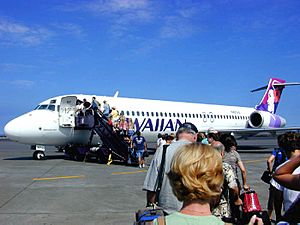
Hawaiian started using the Boeing 717 for flights between the islands in March 2001. On June 4, 2008, the airline announced it would lease four more 717 planes. This was to meet the demand after Aloha Airlines stopped passenger flights and ATA Airlines closed. These planes were delivered between September and the end of 2008.
Planes for Medium and Long Flights
Airbus A321neo
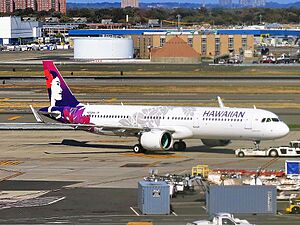
In January 2013, Hawaiian agreed to order 16 A321neo planes, with an option for 9 more. These planes have 189 seats in two classes. After agreements with the pilot and flight attendant unions, the airline finalized the order in March 2013. In December 2016, Hawaiian said they would lease two more A321neo planes, bringing their total to 18. The first flight was on January 17, 2018, from Kahului to Oakland, California.
Airbus A330-200
On November 27, 2007, Hawaiian Airlines agreed to buy 24 long-range jets for $4.4 billion. This order included six Airbus A330-200s and six Airbus A350-800s. Deliveries for the A330s began in 2010. When the A350-800 was no longer being developed, Hawaiian chose six A330-800s instead.
On October 27, 2008, Hawaiian announced it would lease two more Airbus A330-200 planes starting in 2011. They also extended the leases of two Boeing 767-300ER planes until 2011. Two weeks later, the airline announced the lease of another A330-200 for delivery in the second quarter of 2010. In December 2010, Hawaiian ordered six more A330-200 planes, bringing the total to 15. More lease agreements were signed, bringing the A330-200 fleet to 22. In July 2015, Hawaiian announced the lease of an A330-200. The purchase of another A330-200 was announced in December 2016.
Boeing 787-9
In February 2018, there were rumors that Hawaiian would cancel its order for six A330-800s and replace them with 787-9s. On March 6, 2018, Hawaiian Airlines confirmed they canceled the A330-800 order. They signed an agreement with Boeing to buy ten 787-9 planes, with options for ten more. The deal was finalized in July 2018. On January 4, 2023, Hawaiian announced that two more 787-9 planes would be added to its order, making a total of 12. After several delays, Hawaiian received its first 787-9 in January 2024. It first started flying to the West Coast.
Past Planes
Over the years, Hawaiian Airlines has used many different types of planes, including:
| Aircraft | Introduced | Retired | Notes |
|---|---|---|---|
| ATR 42 | 2014 | 2021 | Used by the former 'Ohana by Hawaiian for inter-island flights. |
| Beechcraft Model 18 | 1947 | Unknown | Used for special flights and pilot training. |
| Bellanca CH-300 Pacemaker | 1929 | 1933 | Original plane. |
| Boeing 767-300 | 2006 | 2018 | Flew from Hawaii to the U.S. mainland. |
| Boeing 767-300ER | 2001 | 2019 | |
| Convair CV-340 | 1953 | 1973 | Convair CV-640 was also used, with turboprop engines. |
| de Havilland Canada DHC-7 Dash 7 | 1981 | 1994 | Could take off and land on short runways. |
| Douglas DC-3 | 1941 | 1966 | |
| Douglas DC-6 | 1958 | 1969 | |
| Douglas DC-8-60 | 1983 | 1993 | Included DC-8-62 and DC-8-63 planes. |
| Lockheed L-188 Electra | 1970 | 1980 | Used only for cargo. |
| Lockheed L-1011 TriStar | 1985 | 1994 | Replaced by McDonnell Douglas DC-10. |
| McDonnell Douglas DC-9-10 | 1966/1985 | 1971/1992 | First jet used by Hawaiian Airlines. |
| McDonnell Douglas DC-9-30 | 1968 | 1975 | Replaced by McDonnell Douglas DC-9-50. |
| McDonnell Douglas DC-9-50 | 1975 | 2001 | Replaced by Boeing 717-200. |
| McDonnell Douglas DC-10-10 | 1994 | 2003 | Replaced by Boeing 767-300ER. |
| McDonnell Douglas DC-10-30 | 1999 | 2001 | Leased from American Airlines and Continental Airlines. |
| McDonnell Douglas MD-81 | 1981 | 1990 | |
| NAMC YS-11 | 1966 | 1967 | |
| Short 330 | 1978 | 1980 | |
| Sikorsky S-38 | 1929 | 1942 | A seaplane. |
| Sikorsky S-43 | 1935 | 1946 | A seaplane. |
| Vickers Viscount | 1963 | 1964 |
Services on Board
Food and Drinks
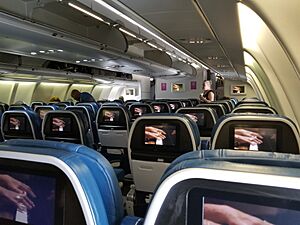
Hawaiian Airlines offers free and paid drinks on all its flights. Meals are not given on inter-island flights because they are very short (30–45 minutes). On flights to the U.S. mainland, Hawaiian is one of the few major U.S. airlines that still gives free meals in its main cabin. Each meal is made with natural ingredients and comes in recyclable packaging. In 2009, Hawaiian started offering premium meals in the main cabin. Passengers could choose the free meal or pay to upgrade to a premium meal. These premium meals were high-end Asian dishes, but they were later stopped.
In March 2007, Hawaiian introduced a "tasting menu" for its first-class passengers on U.S. mainland and international flights. This menu had twenty different main dishes that changed. Five were available on any given flight. Passengers could choose up to three dishes as part of their meal.
In August 2012, Hawaiian announced improvements to its economy class service on U.S. mainland flights. These included a new menu, a free glass of wine on lunch or dinner flights, and a free tropical drink before landing on breakfast flights. This was different from other airlines, which were cutting back on meal service. Mark Dunkerley, who was the CEO at the time, said: "In today's competitive world you cannot justify providing complimentary meals on a traditional business model. It simply does not pay for itself... which explains why essentially everybody has taken all that free food off the airplane. We're being illogical by actually investing heavily in this area...It's part of who we are, and it's what makes us different from everybody else."
Starting December 1, 2017, main cabin guests on Hawaiian flights between Hawaii and western U.S. cities received free meal service. These meals were specially created for the airline's new Pau Hāna Café brand. The Pau Hāna Café, named after the Hawaiian term for "finished work," offers a continental breakfast box for brunch and a hot sandwich with a side for lunch.
On December 20, 2017, Hawaiian announced a partnership with Mana Up. This company helps local Hawaiian businesses that make consumer goods. The goal was to offer more locally made products on board.
In February 2024, the airline announced it would offer free in-flight Wi-Fi provided by SpaceX's Starlink. This made it the first major U.S. airline to offer this satellite-based service. The cost was not shared. This came at a time when other airlines were adding more high-speed internet options. This followed an agreement signed in April 2022 to use the Starlink network, which allowed the company to offer in-flight Wi-Fi for the first time.
Accidents and Incidents
- On December 23, 2000, a Hawaiian Airlines McDonnell Douglas DC-10 flight HA481 went off the end of the runway at Faa'a International Airport in Papeete. An investigation found that this happened because the plane's spoilers were not set correctly and the crew decided to land during a thunderstorm. No one was hurt.
- On May 1, 2015, a Hawaiian Airlines Boeing 767 flight HA24 from Kahului Airport to Oakland, California, returned to the airport because of smoke in the cabin. Passengers left the plane using the emergency slides. Two people had minor injuries.
- On May 15, 2015, a Hawaiian Airlines Boeing 717 flight HA118 from Daniel K. Inouye International Airport to Kona International Airport started letting out smoke from one of its engines. It landed at Kahului Airport, where fire trucks put out the fire. No one was hurt, and no evacuation was ordered.
- On August 13, 2018, a Hawaiian Airlines Airbus A321neo flight HA56 had a tailstrike when landing at Los Angeles. This caused a lot of damage to the plane, but no one among the 197 passengers and crew was injured.
- On August 22, 2019, an Airbus A321neo flying from Oakland to Honolulu (flight HA47) landed safely in Honolulu after the cabin started filling with smoke. Seven people were taken to the hospital for breathing in smoke. No one among the 191 passengers and crew was seriously hurt. Hawaiian Airlines believed the problem was caused by a faulty engine seal.
- On December 18, 2022, a Hawaiian Airlines Airbus A330-243 (N393HA), flight HA35, flew into very strong turbulence 30 minutes before landing in Honolulu from Phoenix, Arizona. Out of 291 people on board, no one died. However, 36 passengers and crew members were injured, with 20 taken to the hospital and 11 in serious condition. The plane was also damaged.
See also
 In Spanish: Hawaiian Airlines para niños
In Spanish: Hawaiian Airlines para niños
- List of airlines of Hawaii
- Hana Hou!, Hawaiian's in-flight magazine
- Air transportation in the United States




